Summary
This article delves into how the PageRank algorithm, typically used by Google for ranking web pages, can be applied to uncover the success dynamics of IPL cricket teams. It provides crucial insights into what drives a team's performance and rankings. Key Points:
- Network-based analysis reveals hidden team dynamics and performance patterns, offering insights into the factors driving success or failure.
- The damping factor balances extreme outcomes, leading to a more accurate and equitable ranking system.
- Winning margins are identified as pivotal in determining rankings, highlighting the importance of victory beyond just win-loss results.
Network-Based Analysis for Unraveling Team Dynamics and Performance
In the realm of sports analytics, Katz centrality offers a sophisticated method for evaluating team performance by assigning weights to the paths between nodes in a network. This allows for a nuanced consideration of each team's importance beyond simple win-loss records. By incorporating factors such as the number and length of winning streaks, Katz centrality provides a more holistic view of how well teams are performing.Similarly, leveraging network science to analyze team dynamics can significantly enhance our understanding of player and team interactions. Constructing player-team networks enables researchers to identify key players, trace player movements, and measure individual influence on overall team success. Techniques like modularity and various centrality measures can offer insights into a team's structure, cohesion, and effectiveness. By applying these advanced analytical tools, we can gain deeper insights into what drives successful sports teams.
Key Points Summary
- Visit the official IPLT20 website for comprehensive 2024 statistics, including Orange and Purple Cap standings.
- Check historical records such as highest team totals, like Sunrisers Hyderabad`s score of 277.
- Access detailed analyses, performance metrics, and historical records for each IPL team on Crickit.
- Mumbai Indians and Chennai Super Kings have each won the IPL title five times.
- Gujarat Titans have a notable winning record with 28 wins.
- Virat Kohli holds significant all-time batting records in the IPL.
For all things IPL, from current season stats to historic achievements, you can dive into detailed data on platforms like the official IPLT20 website or Crickit. Whether you`re interested in individual accolades like the Orange and Purple Caps or epic team performances like Sunrisers Hyderabad`s highest score of 277, it`s all there. With teams like Mumbai Indians and Chennai Super Kings leading with five titles each and star players like Virat Kohli setting batting benchmarks, there`s plenty to explore for any cricket enthusiast.
Extended Comparison:| Team | Titles Won | Notable Record | Key Player | Recent Trends |
|---|---|---|---|---|
| Mumbai Indians | 5 | Most IPL Titles (tied with CSK) | Rohit Sharma | Consistently strong performance with balanced team dynamics |
| Chennai Super Kings | 5 | Most IPL Titles (tied with MI) | MS Dhoni | Known for their tactical gameplay and experienced roster |
| Sunrisers Hyderabad | - | Highest Team Total Score: 277 runs in an inning | David Warner | Struggling to maintain consistency in recent seasons despite high-scoring games |
| Gujarat Titans | - | 28 Wins Notable Record | Hardik Pandya | Emerging as a strong contender with significant match wins |
| Royal Challengers Bangalore | - | Significant All-time Batting Records by Virat Kohli | Virat Kohli | Strong individual performances but inconsistent team success |
I began my analysis with a rudimentary implementation of PageRank, opting to use a straightforward adjacency matrix that tracked wins and losses instead of the more complex Google Matrix. My objective was primarily exploratory—to observe the outcomes. This approach yielded the following ranking results for last season:
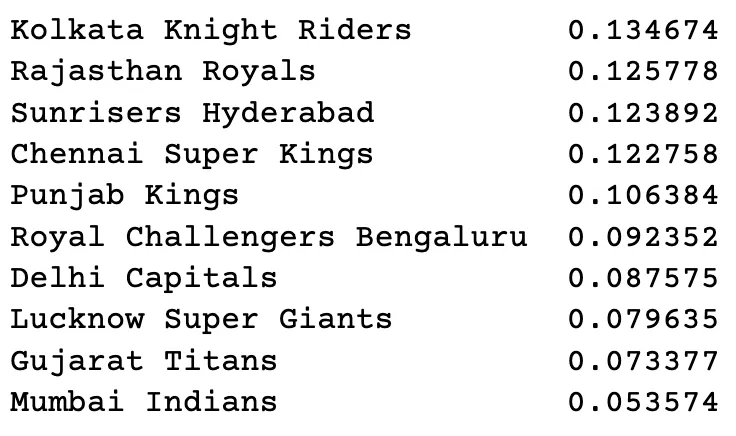
On the surface, it seems logical, though one might expect KKR to have a clearer lead over the other teams and perhaps rank Sunrisers higher than the Royals. It's also surprising to see RCB in sixth place, despite their strong comeback in the latter half of the season mostly consisting of wins against lower-ranked teams. These ratings can also be used to calculate win probabilities by dividing a team's rating by the combined ratings of both competing teams. For instance, according to this model, KKR had only a 52% chance of beating SRH in any given match last season, even though they won all three encounters against them.
Dampening the Undue Influence of Extremes in Sports League Rankings
Incorporating a damping factor into the Google matrix effectively models real-world scenarios in sports leagues by accounting for teams' varying levels of prior win probability. This approach helps mitigate the undue influence of undefeated streaks or the lack of direct matchups.}{By introducing a damping factor, we simulate a "mean reversion" effect where teams with extreme win-loss records are moderated towards more realistic expectations. This adjustment ensures that both exceptionally high and low-performing teams are evaluated more accurately within their league's context, providing a balanced ranking system.
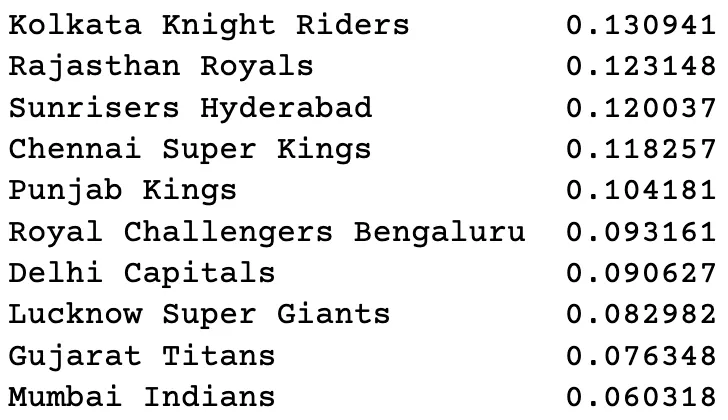
The overall standings remain largely unchanged, but there are slight improvements for the lower-ranked teams and minor setbacks for the higher-ranked ones. This outcome is anticipated since the damping factor theoretically balances out the expected results when a strong team faces a weaker opponent.
Winning Margins: A Key Factor in Cricket Team Rankings
In the innovative ranking system for cricket teams, winning margins play a crucial role in determining link weights between competing teams. Teams that secure victories with more substantial winning margins are assigned higher weights, signifying a stronger performance and connection. This approach diverges from traditional methods by shifting focus to resource utilization rather than solely relying on wickets and runs. By quantifying winning margins through the resources used by the chasing team, this method offers a nuanced evaluation that accommodates various match formats, including those affected by DLS (Duckworth-Lewis-Stern) calculations. The emphasis on how efficiently a team uses its resources provides a more comprehensive understanding of their relative strength and performance across different scenarios.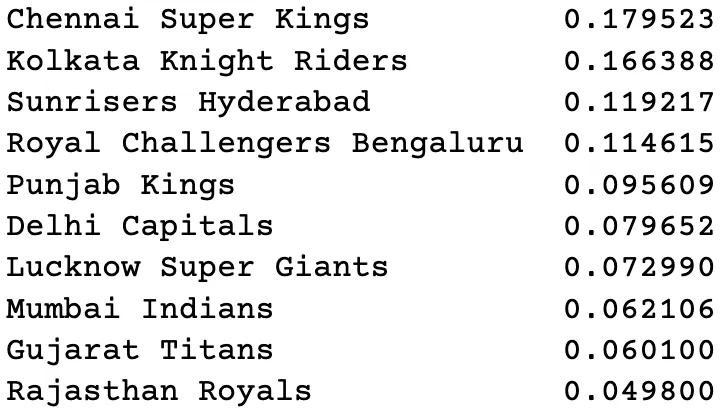
Evaluating Cricket Team Performance: Considering Victory Margins and Context
To enhance the evaluation of a team's performance in cricket, it's important to consider the significance of different victory margins. Assigning varying weights to wins based on the margin can provide a more accurate reflection of the team's dominance. For instance, victories by over 30 runs could be given higher weight compared to narrow-margin wins.Additionally, analyzing contextual factors is crucial for a comprehensive assessment. By incorporating elements such as the strength of the opposition, venue conditions, and weather impacts, we can gain deeper insights into what influenced the game's outcome. This holistic approach ensures that evaluations are not solely based on match results but also account for external variables that affect team performance.
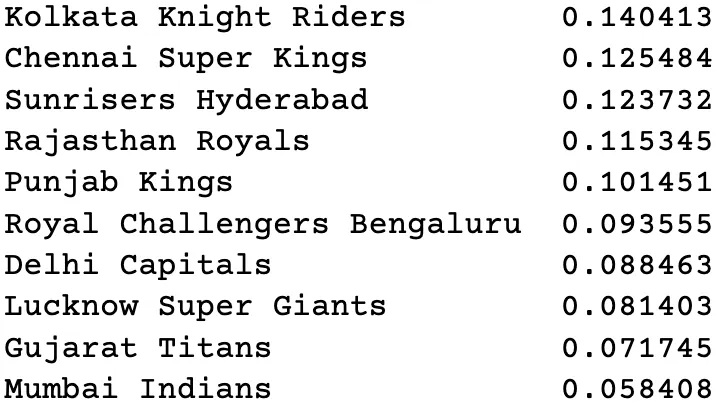
These statistics start to make more sense when we delve deeper. Chennai secured several significant victories, such as their win against the Sunrisers, and managed to keep their defeats relatively tight. Yet, it's important to differentiate between regular wins and commanding victories. To ensure fairness, the "bonus" weight based on win margins will be capped at 0.2. This limit corresponds to scenarios like chasing a target within 16 overs or an opponent scoring 128 while chasing 160. Consequently, this adjustment results in minimal changes to the ratings:
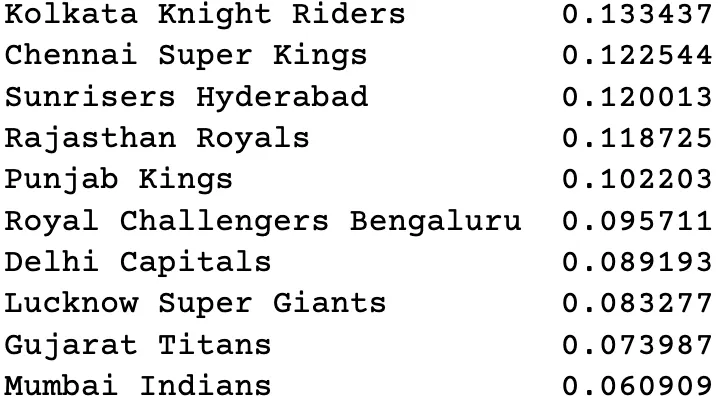
Despite Kolkata’s substantial victories, which were numerous, they have faced significant drawbacks. Nevertheless, the team still holds a comfortable lead at the top of the rankings. While these standings appear logical at first glance, a closer look at their evolution throughout the IPL reveals a more complex picture.
These rankings initially seem straightforward and justified; however, examining how they fluctuated during the IPL season uncovers intricate dynamics and unexpected shifts.
Enhancements to Improve Ranking System Precision and Depth
To enhance the precision and depth of our ranking system, two pivotal improvements are proposed. Firstly, implementing a penalty mechanism for losses can counterbalance the distorting effect of wins. By introducing a system that deducts rating points from teams that lose matches, we achieve a more balanced reflection of team rankings.Secondly, integrating additional factors into the PageRank algorithm can significantly improve its accuracy. Currently, the algorithm solely considers wins and outbound links. By incorporating elements such as match results against common opponents, historical performance data, and player statistics, we create a more comprehensive assessment framework. This mitigates the undue influence of isolated victories and provides a holistic view of team performance. These enhancements collectively contribute to a more robust and insightful ranking system.
To address this, the paper suggests integrating the PageRank score with a "negative rank," where outbound links are generated after wins instead of losses. This essentially means applying PageRank to the transpose of the traditional PageRank adjacency matrix. In essence, Negative PageRank shifts focus from the quality of wins to the quality of losses. Here is how negative rank scores have evolved throughout the IPL:
A negative PageRank score signifies a higher loss quality; hence, a smaller negative rank reflects better performance despite losses. Kolkata's commanding presence is unmistakable in this chart - they not only suffered minimal defeats but also fell only to formidable opponents. Lucknow's unexpectedly high loss quality stands out, as the sole team outside the top three that managed to beat them was Delhi (twice), which itself was no weak contender. In contrast, Sunrisers faced defeats against Gujarat, Bengaluru, and Mumbai, though qualitatively one might anticipate a greater disparity with RCB. By merging both rankings (PageRank and NegativeRank), we derive the following dual-directional PageRank:
The Unpredictability and Complexity of IPL Team Performance Forecasting
The Indian Premier League (IPL) is a tournament known for its unpredictable and chaotic nature. Teams often experience wild swings in form, making it challenging for any ranking system to accurately forecast the final outcomes. This volatility is compounded by the streaky performance of IPL teams, where they can go through phases of consecutive wins or losses. Given that the season consists of only 60 matches, even a few good or bad results can significantly alter a team's position in the standings. Therefore, predicting team performance over such a short span becomes highly complex and uncertain.Predicting mid-table clashes in the IPL often presents a formidable challenge due to the closely matched capabilities of most teams. Consequently, many playoff spots are determined by net run rate rather than outright wins or losses. Nonetheless, IPL squads frequently embark on winning or losing streaks, disrupting these predictive models as they fail to differentiate between pre-streak and streak performance accurately.
For instance, both RCB and RR experienced seasons dominated by extended streaks, severely limiting the model's accuracy in forecasting their match outcomes during the latter half of their campaigns. This inconsistency underscores the difficulty in making reliable predictions when teams exhibit such volatile forms throughout the season.
The initial challenge likely cannot be addressed using PageRank due to the limited number of matches played in the IPL, which is insufficient to fine-tune the model before the season concludes. However, applying the PageRank algorithm to international matches might offer a more suitable solution. The subsequent issue might be resolved by reducing the significance of older games - for instance, by halving the importance of a team's matches beyond their most recent eight. This leaves us with the following chart:
Refining Predictive Sports Models: Optimizing Damping Factor and Weightage Parameters
In the realm of predictive modeling for sports, understanding the influence of various factors and parameters is crucial for enhancing accuracy. One pivotal aspect is the **impact of damping factor and recent matches**. The damping factor determines how much weight to assign to past performances, with a higher value giving more importance to historical data. Conversely, focusing on a shorter range of recent matches highlights current form and performance trends. This balance is essential as it directly affects prediction accuracy, especially for teams with inconsistent performance over time.Additionally, the model's sensitivity to **weightage parameters** plays a significant role in determining team strength and rankings. Parameters such as the emphasis on large victories, maximum weights assigned to wins and losses, and the relative importance of positive versus negative PageRanks are critical hyperparameters that need fine-tuning. Adjusting these weightages can significantly alter predictions, particularly for teams like RCB (Royal Challengers Bangalore) and RR (Rajasthan Royals), which demonstrate contrasting performance patterns. Careful optimization of these parameters involves a deep understanding of the underlying data and aligning them with desired outcomes to refine predictions effectively.
Understanding these nuanced elements—damping factor adjustments for historical versus recent match weighting and precise calibration of weightage parameters—can immensely improve model fidelity in capturing team dynamics accurately over time.
Assessing the Predictive Accuracy of Bidirectional PageRank Models
Evaluating the accuracy of bidirectional PageRank models requires a distinct approach compared to traditional PageRank models. Unlike the original PageRank that provides win probabilities, bidirectional PageRank necessitates an alternative method for assessing its precision. This can be achieved by quantifying the model's capability to predict match outcomes as either wins or losses and calculating the percentage of correct predictions over a comprehensive set of matches.Moreover, assessing long-term forecasting is critical in determining the model's accuracy and stability. By employing temporal analysis over extended periods, such as an entire season or across multiple seasons, one can better understand the predictive performance and robustness of the model. Additionally, evaluating how well the model performs across different leagues or sports will provide further insights into its generalizability and applicability.
Regrettably, I was unable to develop a model that definitively outperforms the win ratio in predicting team performance. However, by the conclusion of this endeavor, it is my hope that this model will serve as a proof-of-concept, demonstrating the predictive potential of PageRank-based models in cricket.
References
IPL 2024 Statistics | Team and Player Stats
View IPL 2024 statistics including orange and purple cap with all time records on the official website of the IPLT20.
Source: Indian Premier LeagueList of Indian Premier League records and statistics
Position of teams in IPL. Year, 1st, 2nd, 3rd, 4th ... ^ "Sunrisers Hyderabad Make History with Highest Team Total in IPL, Score 277 ...
Source: WikipediaIPL 2024 Team Stats
Dive into detailed analyses, historical records, and performance metrics tailored for each IPL team. With Crickit, stay ahead of ...
Source: Hindustan TimesIndian Premier League Records - Cricket's Remarkable Feats
Full lists of all Indian Premier League stats and records, from 2008. Most runs in the IPL, most wickets, highest score, best batting strike rate, ...
Source: ESPNcricinfoTeams with most wins in IPL - Times of India - IndiaTimes
Teams with most wins in IPL Gujarat Titans. 28 · Chennai Super Kings. 138. WIN %: 57.74 | MATCHES: 239 | LOSS: 98 | TIED: 1 | NR: 2 ...
Source: Times of IndiaIPL 2024 Stats: Batting, Bowling, Fielding Records along with Highest ...
Two teams — Mumbai Indians and the Chennai Super Kings — have won the title five times each. In terms of all-time batting records, Indian cricket talisman Virat ...
Source: The Indian ExpressIndian Premier League
IPL team, Salary. Mitchell Starc, Kolkata Knight Riders (KKR), Rs 24.75 Crore ... Teams' performances. Seasons. Season (No. of ...
Source: Wikipedia(PDF) IPL Team Performance Analysis: A Multi- Criteria Group ...
This paper aims to analysis the team performances during first six sessions of IPL in the field of sports Data Mining. The proposed work deals with five ...
Source: ResearchGate


 ALL
ALL sports
sports
Discussions